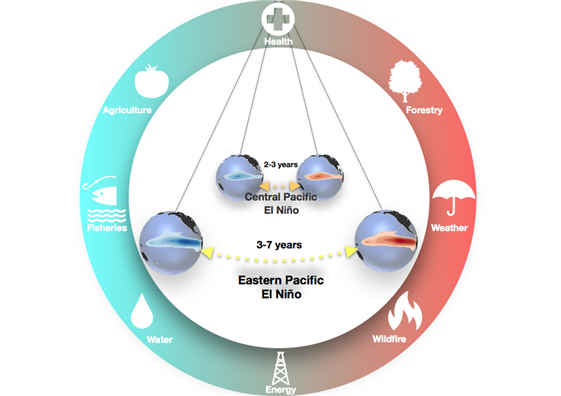일반공지
APEC Climate Center's Dr. WonMoo Kim part of international research team to publish an article on ENSO complexity in the journal Nature
- 작성자
- Admin
- 작성일
- 2018.08.16
- 조회
- 734

Figure: Schematic illustration of the two atmosphere/ocean oscillations
Dr. WonMoo Kim was a member of a team of international researchers that recently published an article on ENSO complexity in the journal Nature ( https://www.nature.com/articles/s41586-018-0252-6 ) together with the IBS Center of Climate Physics.
This new research study isolates key mechanisms that cause El Niño events to differ amongst each other.
The team found that the complexity and irregular occurrence of El Niño and La Niña events can be traced back to the co-existence of two coupled atmosphere-ocean oscillations, with different spatial characteristics and different frequencies.
This study reveals that there is a hidden structure in the seemingly chaotic and unpredictable occurrence of El Niño events.
El Niño events are characterized by an unusual warming of the central to eastern equatorial Pacific, which can last up to one year. Many events subsequently transition to a La Niña (cold) state, with a typical duration of 1-2 years. El Niño events, which tend to peak in boreal winter, typically lead to a drying of Southeastern Asia and the Western tropical Pacific whilst enhancing rainfall near the eastern Pacific shores, in countries such as Ecuador and Peru. El Niño’s remote “ripple effects” can not only be found in the atmosphere, but also in ocean currents, ecosystems, the occurrence of natural disasters, global markets and national economies.
Climate scientists have long recognized that not every El Niño is alike. Some are weak, others are strong. Some occur in the central Pacific, others in the east. These differences will determine which areas will be hit hardest by climatic extremes and which ones will be spared. Predicting El Niño events accurately requires a deeper understanding of its diversity or as some scientists call it — its “flavors”.
Analyzing large amounts of climate observations and computer model simulations, the team unraveled the mechanism behind El Niño’s capricious behavior. When the upper tropical Pacific Ocean stores more heat, El Niño events tend to peak in the Eastern Pacific and during boreal winter, whereas a cooler upper ocean system leads preferably to the development of Central Pacific El Niño events, which exhibit a weaker seasonal coupling.
By running El Niño computer model simulations for different temperature, wind and ocean current configurations the research team found that Eastern Pacific El Niño events are characterized by a return time of 3-7 years, whereas Central Pacific events tend to recur on average every 2-3 years (Figure).
The different character of these modes is determined by how strongly atmosphere and ocean interact with each other. In the observations however, the co-existing Eastern and Central Pacific warm/cold swings are far from periodic.
The tropical Pacific climate systems requires additional excitation, either through random weather events or through atmospheric circulation changes induced by temperature changes in the Indian and Atlantic Oceans. These interactions are an important source for El Niño irregularity, and limit how far ahead Tropical Pacific climate anomalies can be predicted.

